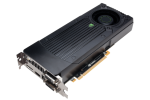3. Metodologia di Prova
Configurazione
Per valutare le prestazioni della NVIDIA GeForce GTX 650 Ti Boost abbiamo utilizzato la nostra tradizionale piattaforma di test.
| Â Processore | Â Intel Core i7-2600K |
| Â Scheda Madre | Â Gigabyte GA-Z68X-UD7-B3 |
| Â Memoria RAM | Â TeamGroup Xtreem LV 2133MHz DDR3 2*4GB |
| Â Hard Disk | Western Digital Velociraptor 150GB |
| Â Alimentatore | Â Antec High Current Pro HCP-1200 |
| Â Sistema Operativo | Microsoft Windows 7 Ultimate SP1 64bit |
| Â Monitor | Dell U3011 - 2560x1600 |
I risultati sono stati comparati con quelli ottenuti delle più recenti schede video in commercio di pari categoria, utilizzando gli ultimi driver disponibili sui siti web di AMD e NVIDIA.
- ZOTAC GeForce GTX 660 Ti Extreme 2GB
- ZOTAC GeForce GTX 660 Ti 2GB
- ZOTAC GeForce GTX 660 2GB
- ZOTAC GeForce GTX 650 Ti AMP! 2GB
- NVIDIA GeFroce GTX 650 Ti 1GB
- Sapphire Radeon HD 7870 XT with Boost 2GB
- Sapphire Radeon HD 7870 GHz Edition 2GB
- AMD Radeon HD 7850 2GB
- Sapphire Radeon HD 7850 1GB
- Sapphire Radeon HD 7790 OC Dual-X 1GB
- Sapphire Radeon HD 7770 Vapor-X 1GB
- AMD Radeon HD 7750 1GB
Benchmark
Per testare le performance nei videogiochi sono stati utilizzati i benchmark integrati o sequenze scriptate alle risoluzioni di 1680x1050, 1920x1080 e 2560x1600 dei seguenti titoli:
- Futuremark 3DMark 11 (Entry - Performance - Extreme) - DX11
- Far Cry 2 (Ultra - AA4x) - DX10
- Crysis Warhead (Extreme - AA4x) - DX10
- Alien vs Predator (Max - AA4x) - DX11
- Metro 2033 (Very High - NO AA) - DX11
- Crysis 2 (Ultra - NO AA) - DX11
- Tom Clancy's H.A.W.X. 2 (Max - AA4x) - DX11









